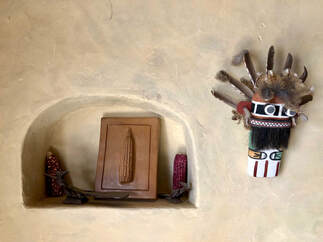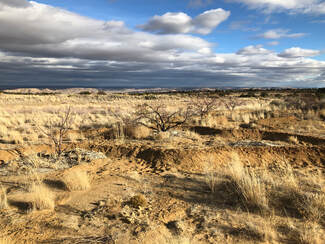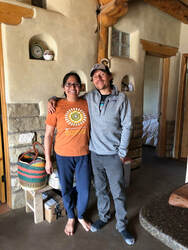Hopi Tutskwa Permaculture Institute

The high winds blow sand across AZ-264 as we travel through the Hopi reservation and land at Kykotsmovi Village, site of the Hopi Tutskwa Permaculture Institute. Lilian Hill and Jacobo Marcus-Carranza founded the institute in 2004, and since then have been guiding mainly Navajo and Hopi youth through internships teaching essential skills in natural building, permaculture techniques, local food production, solar installation, harvesting and selling at local farmers markets, and youth empowerment.
I had visited Lilian and Jacobo last spring as part of a permaculture workshop and partnership with Community Rebuilds, a natural building program and original collaborator with the Hopi Tutswka Permaculture Institute. Since then, I was excited to return. At the workshop, a group of 25 or so from Moab, the Hopi and Navajo Nations all began in a circle, introducing ourselves and tossing a ball of yarn to the next person. There were so many of us that we ran out of yarn and had to move in closer, further demonstrating the interconnectedness between us all – both by the yarn web we created and the closeness to our peers left and right. We spent a large amount of time that day discussing sustainability failures at the local, regional, and national level, broken out in groups with various topic areas such as energy, water, etc. These came to mind easily and within minutes our group’s flipchart was full. When we flipped the story, and had to write down sustainability successes, however, these flowed a little slower at first. They exist, but we can become focused so closely on the problem that solutions thinking is overshadowed; an important realization for all of us. We know the problem – the planet is warming and we have a limited window of about a decade to enact large scale change. However, we haven’t been discussing hope, solutions, and empowerment with the same urgency.
The experience last spring had a lasting impact on me and I was excited to return as part of this research tour. We had eaten delicious, healthy food, connected with each other across cultures and environments, and discussed what we can do to be part of the solution.

Hopi Tutskwa translates from the Hopi language to the life ways and knowledge of the land and soil. Lilian and Jacobo are helping their communities and beyond to reconnect, relearn from, and reshape our relationship with the environment that sustains us, our “Earthmother.”
When I asked Lilian and Jacobo who the main students are that attend their program and what they are looking for, Lilian answered “our main students we are designing programs for are within our own community – so both within Hopi and the surrounding Navajo reservation. We have opened up our programming to other people as well, but mostly very young people who live in the community who may or may not have graduated high school but who for one reason or another have not left. They have stayed and a lot of them remain within their own family structure too – with their parents or grandparents. A lot of the students who come to our program are in an interesting place, in their early 20s and don’t know what they want to do with their lives.”
Jacobo added, “We wanted to design programming to really help folks strengthen their lives in meaningful ways. A lot of the students who are part of the program are just here in the community and a lot of times they don’t have meaningful interactions…I guess with the home they live in, a disconnect between the home they live in and how they can contribute to the home. We are trying to develop programming to help folks have applicable solutions to where they can feel empowered to build their own home, grow their own food, and to catch their water. It’s really important for us to pass that on.”
Their vision “is to strengthen community through the continued intergenerational practices of traditional Hopi farming and gardening, rainwater harvesting and spring restoration, natural building, and orchard-keeping while applying applicable Permaculture principles, methods, and techniques.”
Lilian and Jacobo are working to create a world where:
- Communities practice cooperation in all aspects of life, continuing the traditional Hopi values of Sumi’nangwa and Nami’nagwa which means to help others selflessly for the good of everyone.
- Communities learn to value, care for, respect, protect, and manage the natural environment while ensuring adequate resources for the future generations.
- Communities will learn innovative ways towards creating sustainable communities locally and regionally.
- Communities have clean water, good nutritious food, and thriving ecosystems and watersheds.
Discover more about Lilian, Jacobo, and the Hopi Tutskwa Permaculture Institute at: https://www.hopitutskwa.org/


Recent Posts

